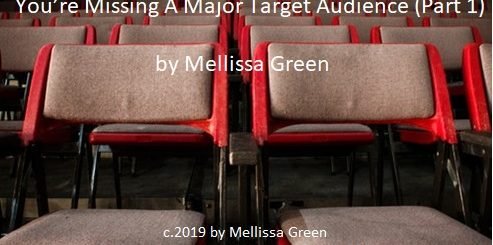Not Enough Website Views? You’re Missing A Major Target Audience (Part 2) by Mellissa Green
 Today we welcome back a new guest writer to Writer’s Fun Zone, Mellissa Green who is stopping by to chat with us about “Not Enough Website Views? You’re Missing A Major Target Audience (Part 2).” Enjoy!
Today we welcome back a new guest writer to Writer’s Fun Zone, Mellissa Green who is stopping by to chat with us about “Not Enough Website Views? You’re Missing A Major Target Audience (Part 2).” Enjoy!
In the part 1 post, Mellissa covered the importance of web accessibility, simple things you can do to make your website accessible and how to make sure your site is accessible.
***
LAWS REGARDING WEB ACCESSIBILITY
Just as there are copyright laws, there are laws regarding web accessibility.
In the U.S., there are two governing acts that cover disabilities the Americans With Disabilities Act of 1990, and the Rehabilitation Act of 1973.
The ADA recognizes and protects the civil rights of people with disabilities and is modeled after earlier landmark laws prohibiting discrimination on the basis of race and gender. It was signed into law by George H.W. Bush on July 26, 1990.
The ADA covers a wide range of disability, from physical conditions affecting mobility, stamina, sight, hearing, and speech to conditions such as emotional illness and learning disorders and covers:
- the workplace (title I)
- state and local government services (title II)
- places of public accommodation and commercial facilities (title III)
- telecommunications for people who have hearing or speech impairments through telecommunications relay services (title IV)
It also includes miscellaneous instructions to Federal agencies that enforce the law (title V).
Regulations issued under the different titles by various Federal agencies set requirements and establish enforcement procedures. To understand and comply with the ADA, it is important to follow the appropriate regulations.
Under titles II and III of the ADA, the Board develops and maintains accessibility guidelines for buildings, facilities, and transit vehicles and provides technical assistance and training on these guidelines. The ADA Accessibility Guidelines (ADAAG) serve as the basis of standards issued by the departments of Justice (DOJ) and Transportation (DOT) to enforce the law. The building guidelines cover places of public accommodation, commercial facilities, and State and local government facilities. The vehicle guidelines address buses, vans, a variety of rail vehicles, trams, and other modes of public transportation.
Regulations issued by DOJ and DOT contain standards based on ADAAG and also provide important information on which buildings and facilities are subject to the standards. It is important that the regulations be used along with the design standards they contain or reference.
ADA Amendments Act of 2008
Amendments to the ADA signed into law on September 25, 2008, clarify and reiterate who is covered by the law. The copy of the ADA provided below includes these amendments, which became effective January 1, 2009. (Americans with Disabilities Act – United States Access Board)
The Rehabilitation Act of 1973 requires access to programs and activities that are funded by Federal agencies and to Federal employment. The law also established the Access Board (section 502). Later amendments strengthened requirements for access to electronic and information technology in the Federal sector (Section 508). With passage the Patient Protection and Affordable Care Act in 2010, a new provision (section 510) was added to address access to medical diagnostic equipment. The Board plays a lead role in developing and maintaining standards for electronic and information technology under section 508 and medical diagnostic equipment covered by section 510.
Several years after the ABA had become law, Congress observed that compliance had been uneven and that no initiatives to create Federal design standards for accessibility were underway. Clearly, one central agency needed to take charge of enforcing the ABA and ensuring development of design standards. The concept of such an agency began to take shape as Congress considered the Rehabilitation Act of 1973. Section 502 of this law created the Access Board.
Originally named the Architectural and Transportation Barriers Compliance Board. The Board was charged with ensuring Federal agency compliance with the ABA and proposing solutions to the environmental barrier problems addressed in the ABA. Congress was clear in its intent that compliance be the primary essence of the Board’s function.
Section 502 lays out the duties of the Board under the ABA, which include: ensuring compliance with standards issued under the ABA, developing and maintaining guidelines upon which the standards are based, and promoting access throughout all segments of society. This section of the law also outlines the membership and composition of the Board. (Rehabilitation Act of 1973 – United States Access Board)
It’s not that there is an issue with accessibility, which does matter, but many people don’t even know it should be considered. As a web consumer, I go to author sites to check for accessibility, but also to see what is on their site. I’ve found many authors’ websites to be accessible, some not, so I contact those who have inaccessible websites, and bring it to their attention. They’re willing to add in the feature if they can right then, or re-design or create a screen-reader version, if they’ve hand-coded their site.
I can only give a user experience view on making a website accessible and doing this research has provided plenty of information, and ideas for a series of accessibility-related articles.
In creating this article, I discovered that there was plenty of information I didn’t have as far as making the web and websites more accessible. I also learned more about the guidelines and web testing and evaluation.
Remember to talk about accessibility as much as you can. Let’s do our part and make the world more accessible.
***
ABOUT THE AUTHOR
 Nicole Thompson-Andrews writes under the pen name Mellissa Green.
Nicole Thompson-Andrews writes under the pen name Mellissa Green.
Mellissa Green writes dark culinary thrillers that transport readers across the galaxy among other specific genres.
She was born premature in Ann Arbor, Michigan as Nicole Thompson-Andrews. She is a medical miracle! She also writes Scriptural poems and loves speculative fiction. When not writing, she can be found reading Ya thrillers like Goosebumps or other genres like historical fiction like Stella By Starlight.
She can also be found chatting it up on Twitter @ABlueGreenGXY or watching shows such as Criminal Minds or Chicago Med.
Take a nibble at her news at http:///www.tinyletter.com/novelgreen





